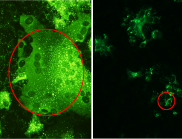New bat virus could hold key to Hendra virus
The new virus – named ‘Cedar’ after the Queensland location where it was discovered – is a close relative of the deadly Hendra and Nipah viruses.
However, CSIRO’s initial studies have discovered one surprising key difference – the Cedar virus does not cause illness in several animal species normally susceptible to Hendra and Nipah.
The new discovery had significant potential implications for protecting animals and humans from the Hendra and Nipah viruses.
Gary Crameri, research scientist, AAHL
This tantalising difference may help scientists understand how to better manage and control its deadly cousins. The findings have been announced today in the journal, PLoS Pathogens, published by the Public Library of Science.
Mr Gary Crameri, research scientist with the bat virus team at CSIRO’s Australian Animal Health Laboratory (AAHL) in Geelong, Victoria, said the new discovery had significant potential implications for protecting animals and humans from the Hendra and Nipah viruses.
“The significance of discovering a new henipavirus that doesn’t cause disease is that it may help us narrow down what it is about the genetic makeup of viruses like Hendra and Nipah that does cause disease and death,” Mr Crameri said.
“The more that we can learn about bat-borne viruses, the better chance we have of developing anti-virals and vaccines to help protect human health, Australia’s livestock industry and our export trade from the threat of current and emerging animal diseases.
“Over 70 per cent of people and animals infected with Hendra and Nipah viruses die. This ranks henipaviruses amongst the deadliest viruses in existence, yet little is known about just how such viruses actually cause disease or death.”
It is still too early to rule out the possibility that Cedar virus may cause illness and death in horses or other animals.
The discovery was a result of a close partnership with Biosecurity Queensland which played an important role by collecting and screening samples from bat colonies across Queensland.
“Field work with bats is an essential part of research into identifying new viruses,” Dr Hume Field of Biosecurity Queensland said. “Bats are being implicated as the natural host of a growing number of viruses in Australia and overseas, yet they appear to tolerate infection themselves making bat research increasingly important.”
Bats have been identified as playing a role in the spread of viruses including Ebola, Marburg, SARS and Melaka yet they are an essential part of our diverse ecosystem through their role as pollinators, seed dispersers and insect regulators.
The discovery is part of ongoing research by CSIRO to target diseases that threaten our animals, people and the environment and is part of CSIRO’s wider biosecurity effort. It follows CSIRO’s development towards a horse vaccine against Hendra virus.
Read more about CSIRO’s Hendra virus research.
See Contact Information to arrange an interview.
- <a href="http://www.daff.qld.gov.au/4790_13149.htm
Cedar Virus: A Novel Henipavirus Isolated from Australian Bats – research article (PLoS Pathogens)”>Biosecurity Queensland
Cedar virus fast facts
- Cedar virus is now the closest known relative to the deadly Hendra and Nipah viruses
- Cedar, Hendra and Nipah viruses all originated in flying foxes, the group of larger bats which only live in Australia and Asia
- Bats are the second most common mammal in the world, after rodents, and an essential component of our ecosystem
- Over 75 per cent of new and emerging diseases in humans originated in animals
- Research targeting new and emerging infectious diseases is part of CSIRO’s wider biosecurity effort
Media resources
Click image for high resolution version.

